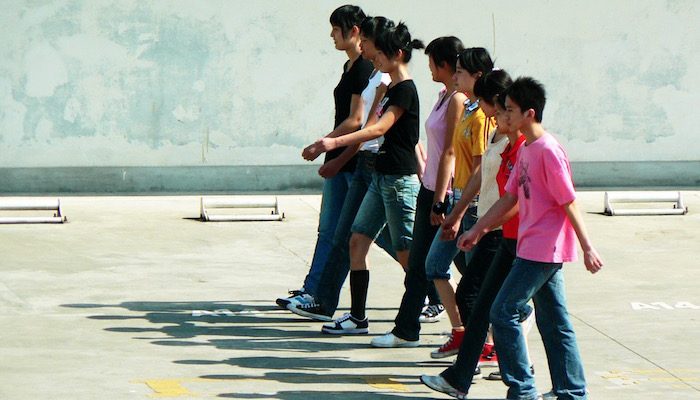
The traditional classroom / teaching environment found in mainland China post-secondary education settings is centered around the permissive socialism model. Typically colleges and universities focus their teaching attentions to and on the more enthusiastic and talented students in the classroom without stringent regard for attendance, tardiness or absenteeism. Some of the compensatory mechanisms for the non-preforming segment of the student population is the ability to re-take tests and exams until the student has passed the course(s). Only under extreme circumstances are students failed, the result of this process places wholly unqualified graduates into the work force.
Students are predominately from single child families and are often detached from the traditional family environment as both parents are engaged in employment and business activities. Often the substitution of monetary freedom and availability and strong cultural paradigms involving filial obligation create resentment that leads towards negative behavior in the post-secondary educational environment. This is compounded by continuing support stipends that have no tangible consequence to enforce educational and academic goals or outcomes.
Most, if not all, Chinese colleges and universities fail to take advantage of an opportunity when post-secondary students attend compulsory military training. This opens a window in which to input the ethical structuring necessary to align the students with the concepts of work ethics associated with degree studies.
Hybridization of Western and Eastern education methods offers a way to harness this transitioning phase and places emphasis on a supportive classroom environment and structure that aligns students towards academic professionalism and proper work ethics that stresses personal responsibility. This effect is enhanced further when the hybridization utilizes a combination of teaching methods that stresses and targets acquisition of skills and knowledge in an egalitarian and meritocratic classroom environment. Elements of the foundation for classroom learning, teaching and management borrow, utilize or mirror results found by leading Western experts such as Karen Spangenberg Postal, Roland G. Fryer, Jr, Steven D. Levitt, John List, Sally Sadoff, and Richard Elmore.
To put this idea into action, freshmen students were met by teachers at the beginning of their military indoctrination drills. This creates a positive initial bond between students and teacher, which provided a solid basis and foundation for the academic environment.
Hybridized classroom structures rely on written rules, obligations and expectations that will shape and guide behavior and conduct and introduce students to the core obligation concept that being a student is in fact their job. The process relies on egalitarian meritocratic metrics that are often foreign to the students. However, this method tends to suppresses “self-entitlement” paradigms by placing all students on an equal footing the classroom. These methods were applied to over nine hundred freshmen and sophomore students attending Vocational College and University in China for a period of three years.
Significance is placed on positive behaviors that include concepts in ethical and moral reasoning. This generally fits well with Chinese State Party doctrine, advances strong work ethics, and praises individual efforts to facing academic and personal “fears” related to classroom and social embarrassment that reflect uncertain and under development skills and knowledge.
This is a departure from permissive socialism structures which favors class leaders, perspective youth party member and the segment of the students whom rely on family status as a means to curry better grades and favoritism towards counterproductive behaviors. E.g. excessive absenteeism and multiple testing. The hybridized method ameliorates undesirable behavior from the onset of classes and shifts ownership and responsibility to the students.
Generally, standard classroom teaching methods parallel the rote memorization practices without great emphasis on acquisition of skill or the ability to manipulate information from lecture and theory into practical application modes. The hybridized method model de-emphasizes rote memorization and instead relies on two-part class presentation of lecture and theory, immediately followed by practical application of the materials. This differs from standard practices as all students are required without exception to participate and that the curriculum formula base is interlocking information that supports each successive lecture.
The hybridized core concept applied is “progress not perfection” this mollifies internal anxiety and allows the students to progress more quickly as it does not cast a critical or negative reflection on the students’ immediate performance.
General proof of concept in comparison between classroom structures using conventional passive methods, formal active methods and hybridization demonstrated that the transitions between military indoctrination the hybridized environment there was significant positive utility. Students typically responded very positively in both general attitude and acquisition of skills and applied knowledge when measured against traditional passive methods and the more formal active methods. Attendance, tardiness and general test scores were also reflective in that students attended well, were rarely late and typically passed the relevant course under the one test, no retest doctrine.
Comparatively when going back into environments that used traditional passive and formal methods the students quickly reverted to less productive practices, leaving a strong impression that a hybridized approach – when used – offers a higher level of utility to the teaching and classroom management environments in China.
Further Reading on E-International Relations
- Working with and Supporting Teaching Assistants
- Teaching International Relations as a Liberal Art
- The Politics of Teaching International Relations in the Arab World: A Critique
- What to Do When You Don’t Like a Topic You Teach?
- Student Mobility and Its Relevance to International Relations Theory
- Getting the Most Out of Class Discussion